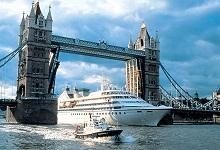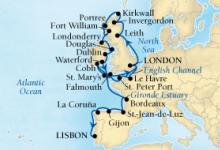Recently Viewed Cruises
- Pride, British Isles & Atlantic Harbors ex London to LisbonAdd to favourites
- Pride, British Isles, Atlantic & Iberia ex London to Monte CarloAdd to favourites
- Ocean Countess, Mini Cruise ex Newcastle to TilburyAdd to favourites
- Wind Surf, ex Dublin to PortsmouthAdd to favourites
- Boudicca, Dublin & Cork D1319 ex Liverpool ReturnAdd to favourites
- Catch up on Cruising: Latest cruise news in bite size
- Royal Caribbean International raises the bar
- Classy Astor fills gap in market
- Oceanic Discoverer
- Ab Fab Oosterdam
- Frequently Asked Questions
-
Pride, British Isles & Atlantic Harbors ex London to Lisbon
Nights 29 Ship Seabourn Pride Star Rating 
Departs London, (London Bridge) England Sailing 2013: 1 Sep Ports of Call London, Edinburgh, Invergordon, Kirkwall, Dunvegan, Fort William, Londonderry, Douglas More Dublin, Dunmore East(Waterford), Falmouth, Le Havre, St. Peter Port, Cobh (Cork), St Mary's Port, Bordeaux, St Jean de Luz, Gijon, La Coruna, Lisbon Please enquire about this cruise for pricing.


29 Night Cruise sailing from London to Lisbon aboard Seabourn Pride.
The ship that started it all inspired one critic to declare that "Seabourn is in a class by itself." And in 1988, when the sleek, 10,000-ton Pride emerged from the Schichau Seebeckwerft shipyard in Bremerhaven, Germany, that was literally true.
At that time, most ships of Pride's size (and there were more then than now) carried more than 400 guests. Seabourn Pride, christened by Ambassador Shirley Temple Black, topped out at half that many.
The idea that every guest sailed in an expansive, ocean-view suite was revolutionary. The concept of open-seating dining accommodating all guests was exceptional. And the notion of including nearly everything for the cost of the fare was a rare thing as well. But the most important element of the Seabourn experience, to founding president Warren S. Titus, was the unparalleled level of personalized service provided to guests.
Hand-picked staff, recruited from the finest European hospitality schools and hostelries, are re-trained and managed according to the philosophy that every request is a golden opportunity to create delight, that the unexpected pleasure is what truly makes an experience memorable, and that the rendering of the very best service is a product of professional pride, not influenced by the expectation of a gratuity.
That remains a core value of all Seabourn ships today. By a trick of history, Seabourn Pride and its sisters remain as exceptional today as they were when launched - in a class by themselves.
Highlights of this cruise:
London
Sail right up the River Thames past Greenwich and under the raised Tower Bridge, to make fast alongside the retired British Royal Navy light cruiser, which is now a museum ship and a permanent fixture of the London riverfront.
Leith (Edinburgh)
Two miles distant from its ancient seaport of Leith lies Edinburgh, Scotland's national capital. The Scottish capital since the 15th century, Edinburgh is comprised of two distinct areas - the Old Town, dominated by a medieval fortress, and the neoclassical New Town, whose development from the 18th century onwards had a far-reaching influence on European urban planning. The harmonious juxtaposition of these two contrasting historic areas, each with many important buildings, is what gives the city its unique character.
Always favored by geography, Edinburgh is ideally situated on the Firth of Forth, an inlet from the North Sea, and built on extinct volcanoes surrounded by woods, rolling hills and lakes. On a clear day, there are glorious vistas from each of these hilltops. Looming above the city is the striking fairy tale castle built on the site of a 7th-century fortress. Towards the Middle Ages life within the fortress spilled onto the long ridge running to the foot of Arthur's Seat, which crowns Holyrood Park. The city's most legendary citizens are the arch Presbyterian John Knox and Mary Queen of Scots, who dominated the Edinburgh of the late 16th century. Edinburgh's delightful city center is a joy to explore on foot. Every alley reveals impressive steeples, jagged, chimney-potted skylines, or lovely rotund domes.
Invergordon
Invergordon, the port for Inverness, is located in the northern part of Scotland on the Moray Firth. The quaint town of Inverness has reminders of such historical figures as St. Columba, Mary Queen of Scots, and Oliver Cromwell. Its attractions include a 17th-century clock tower, part of a fort erected by Cromwell's army and the 19th-century cathedral. Regarded as the "Capital of the Highlands," the town holds many traditional Scottish events each summer.
Kirkwall
Six miles of turbulent waters known as the Pentland Firth separate the northeastern corner of Scotland from Orkney. This archipelago comprised of some 70 islands, only 28 inhabited by humans, was first settled by the Vikings in the 9th century. Ruled by Norway and Denmark until 1468, the islands were given to Scotland by a Norwegian King in lieu of a dowry for his daughter's marriage to James III. Kirkwall is the capital city, located on Mainland, the Orkney's largest island. Explore this fascinating town with its steep-roofed houses and medieval St. Magnus Cathedral, or venture further out of town to see some of the wealth of prehistoric sites, which dot the island. Although politically a part of Great Britain, the archipelago retains a strong sense of Norse traditions as evidenced by the architecture and crafts found here.
Dublin
Ireland's capital offers an almost inexhaustible number of attractions including stately public buildings, handsome 18th-century mansions, imposing statues, superb museums and art galleries, a magnificent cathedral, and Trinity College where the 8th-century Book of Kells is displayed, not to mention the tempting shops along Grafton Street. The proverbial Irish skill with words has richly rewarded the world with essays, novels, plays and poetry by authors ranging from Oliver Goldsmith, William Congreve, Jonathan Swift, George Bernard Shaw and Oscar Wilde to James Joyce, Sean O'Casey, Samuel Beckett and W.B. Yeats. This skill is not confined to the written word - the articulate Irish with their lilting, almost musical vernacular and conversational talent leave no doubt that the Irish genius extends to the spoken word as well.
Falmouth
Falmouth has a fine natural harbor, but has lost its earlier importance as a seaport and now caters mainly to yachts and boating for holidaymakers. Falmouth has the mildest winter climate in England.
Le Havre
Originally built in 1517 on the orders of King Francois I, Le Havre, (the Harbor) grew to become France's second busiest port. Prior to World War II, Le Havre was home port to many of the day's great luxury liners, including the France, the Normandie and Ile de France. Virtually destroyed by bombing raids during the war, the present city is perhaps most notable for being the vision of a single architect, Auguste Perret, during its reconstruction between 1946 and 1964. Two buildings of particular note are the stark Hotel de Ville and the towering church of St. Joseph, with its 99-meter bell tower. The Musee des Beaux-Arts, near the port, features a room devoted to the works of native son Raoul Duffy in addition to a fine collection of 19th and 20th-century French artists.
Cobh
Ireland's second-largest city, Cork takes belligerent pride in its history of rebellion. It was founded in the 4th century by St. Finbarr, for whom its first cathedral is named. Hardly less sacred to its citizens is the Cork City Gaol, where its rebel heroes often resided. Visit the Crawford Art Gallery for its collection of native Irish painters, and Blarney Castle for a look at feudal history. Further afield, nearby Cobh, formerly known as Queenstown, has an Emigration Centre tracing the history of the great Irish diaspora.
Bordeaux
Bordeaux is the starting point for many exciting excursions into the surrounding wine country. The patricians of Bordeaux have always been merchants and shipbuilders. Under the Romans the city had a flourishing trade with Spain and Britain. In 1154, as a part of the dowry of Eleanor of Aquitaine, it became English and remained so until 1453. In the 18th century, Bordeaux prospered from the slave trade, and later in commerce with French colonies in Africa. Since Roman times the quality of the region's vines and wines has been zealously maintained.
Gijon
This ancient port city on the green Atlantic coast of Spain has a history of some 3,000 years. From its humble beginnings the city has grown to become an important port city in Spain. Its old historic fishing village Cimadevilla with its picturesque cobble stoned streets and old-world architecture remains today its main tourist attraction.
Lisbon
The great period of "the Discoveries" accounted for phenomenal wealth brought back from India, Africa and Brazil by the great Portuguese navigators. Gold, jewels, ivory, porcelain and spices helped finance grand new buildings and impressive monuments in Lisbon, the country's capital city. As you sail up the Tagus River, be on deck to admire Lisbon's panorama and see some of the great monuments lining the river. Lisbon is one of Europe's smallest capital cities but considered by many visitors to be one of the most likeable. Spread over a string of seven hills, the city offers a variety of faces, including a refreshing no-frills simplicity reflected in the people as they go unhurriedly through their day enjoying a hearty and delicious cuisine accompanied by the country's excellent wines.





